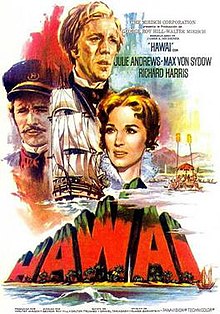
Oahu is the most populated and third-largest of the Hawaiian Islands. The island of Oahu and the Northwestern Hawaiian Islands constitute the City and County of Honolulu. The state capital, Honolulu, is on Oahu's southeast coast. In 2021 Oahu had a population of 995,638, up from 953,207 in 2010.
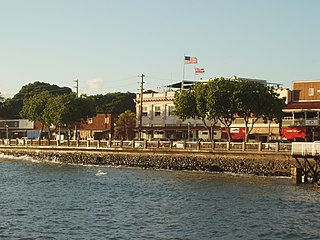
Lahaina is a census-designated place (CDP) in Maui County, Hawaii, United States. On the northwest coast of the island of Maui, it encompasses Lahaina town and the Kaanapali and Kapalua beach resorts. As of the 2020 census, Lahaina had a resident population of 12,702. The CDP spans the coast along Hawaii Route 30 from a tunnel at the south end, through Olowalu, and to the CDPs of Kaanapali and Napili-Honokowai to the north.

The ʻIolani Palace was the royal residence of the rulers of the Kingdom of Hawaiʻi beginning with Kamehameha III under the Kamehameha Dynasty (1845) and ending with Queen Liliʻuokalani (1893) under the Kalākaua Dynasty, founded by her brother, King David Kalākaua. It is located in the capitol district of downtown Honolulu in the U.S. state of Hawaiʻi. It is now a National Historic Landmark listed on the National Register of Historic Places. After the monarchy was overthrown in 1893, the building was used as the capitol building for the Provisional Government, Republic, Territory, and State of Hawaiʻi until 1969. The palace was restored and opened to the public as a museum in 1978. ʻIolani Palace is the only royal palace on US soil.

Bernice Pauahi Pākī Bishop KGCOK RoK was an aliʻi (noble) of the royal family of the Kingdom of Hawaii and a well known philanthropist. At her death, her estate was the largest private landownership in the Hawaiian Islands, comprising approximately 9% of Hawaii's total area. The revenues from these lands are used to operate the Kamehameha Schools, which were established in 1887 according to Pauahi's will. Pauahi was married to businessman and philanthropist Charles Reed Bishop.

Mauna ʻAla in the Hawaiian language, is the Royal Mausoleum of Hawaii and the final resting place of Hawaii's two prominent royal families: the Kamehameha Dynasty and the Kalākaua Dynasty.

Jocelyne Bredin LaGarde was a Native Tahitian actress who became famous for her first and only acting role in the 1966 motion picture, Hawaii, for which she was nominated for an Academy Award for Best Supporting Actress.

A heiau is a Hawaiian temple. Made in different architectural styles depending upon their purpose and location, they range from simple earth terraces, to elaborately constructed stonen platforms. There are heiau to treat the sick, offer first fruits, offer first catch, start rain, stop rain, increase the population, ensure the health of the nation, achieve success in distant voyaging, reach peace, and achieve success in war (luakini).

Kalanikauikaʻalaneo Kai Keōpūolani-Ahu-i-Kekai-Makuahine-a-Kama-Kalani-Kau-i-Kealaneo (1778–1823) was a queen consort of Hawaiʻi and the highest ranking wife of King Kamehameha I.
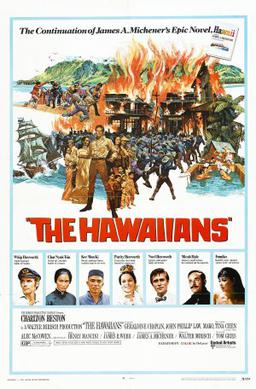
The Hawaiians, released in the UK as Master of the Islands, is a 1970 United States historical epic based on the 1959 novel Hawaii by James A. Michener. Starring Charlton Heston at the head of an ensemble cast, the two and one-half hour saga was directed by Tom Gries from a screenplay by James R. Webb. Tina Chen received a Golden Globe best supporting actress nomination.
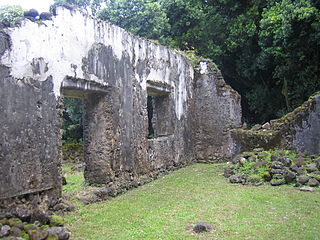
Kaniakapūpū, known formerly as Luakaha, is the ruins of the former summer palace of King Kamehameha III and Queen Kalama on the island of Oahu in Hawaii. Built in the 1840s, and situated in the cool uplands of the Nuʻuanu Valley, it served as the king and queen's summer retreat after the capital of the Kingdom of Hawaii moved from Lahaina to Honolulu in 1845. It was famous for being the site of a grand luau attended by an estimated ten thousand guests during the 1847 Hawaiian Sovereignty Restoration Day celebration. The palace had fallen into ruins by 1874; no records exist about its condition in the intervening years. Rediscovered in the 1950s, the site was cleared and efforts were made to stabilize the ruins from further damage by the elements and invasive plant growth. The site remains officially off-limits to the public and trespassers are subjected to citations, although the site is not regularly monitored.

Kameʻeiamoku was a Hawaiian high chief and the Counselor of State to King Kamehameha I. He was called Kamehameha's uncle, but he was really the cousin of Kamehameha's mother, Kekuiapoiwa II.
Kalaninuiamamao was a prince of the Big Island of Hawaiʻi, or 1st Aliʻi Nui of Kaʻū, an ancestor of the Queen Liliuokalani. He is probably the Hawaiian chief with the most varied spelling of his name.

The island of Maui with a relatively central location has given it a pivotal role in the history of the Hawaiian Islands.

The Hawaiian Kingdom, also known as Kingdom of Hawaiʻi, was a sovereign state located in the Hawaiian Islands which existed from 1795 to 1893. It was established during the late 18th century when Hawaiian chief Kamehameha I, from the island of Hawaiʻi, conquered the islands of Oʻahu, Maui, Molokaʻi, and Lānaʻi, and unified them under one government. In 1810, the Hawaiian Islands were fully unified when the islands of Kauaʻi and Niʻihau voluntarily joined the Hawaiian Kingdom. Two major dynastic families ruled the kingdom, the House of Kamehameha and the House of Kalākaua.

Dwight Baldwin was an American Christian missionary and medical doctor on Maui, one of the Hawaiian Islands, during the Kingdom of Hawaii. He was patriarch of a family that founded some of the largest businesses in the islands.

Lorrin Andrews was an early American missionary to Hawaii and judge. He opened the first post-secondary school for Hawaiians called Lahainaluna Seminary, prepared a Hawaiian dictionary and several works on the literature and antiquities of the Hawaiians. His students published the first newspaper, and were involved in the first case of counterfeiting currency in Hawaii. He later served as a judge and became a member of Hawaii's first Supreme Court.

Waiola Church and Cemetery in Lāhainā is the site of a historic mission established in 1823 on the island of Maui in Hawaiʻi. Originally called Waineʻe Church until 1953, the cemetery is the final resting place for early members of the royal family of the Kingdom of Hawaii.
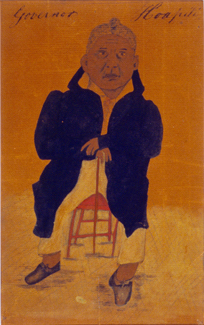
Ulumāheihei Hoapili was a member of the nobility during the formation of the Kingdom of Hawaii. He was a trusted military and political advisor to King Kamehameha I, known as "Kamehameha the Great". Although trusted with one of the last symbolic rites of the Hawaiian religion, he later became a supporter of Christian missionaries.
Ke AliʻiKilinahe was a kaukau aliʻi noble who served under the ruling ali'i nui of the islands of Hawaii, Maui and Oahu, during the Kingdom of Hawaii. He is of the House of Moana and a collateral family of the House of Kamehameha. He performed his hana lawelawe or "service task" under Ka'ahumanu and Kamehameha III, starting as a kāhili bearer and royal attendant. He was brought into the Royal Court by Charles Kanaina to assume all of his duties and responsibilities. He toured Oahu with the Royal Circuit and managed the chief's goods. Kilinahe, in the Hawaiian language, means "light rain".
Jonah Kapena, also spelled Iona Kapena, was a royal advisor and statesman in the Kingdom of Hawaii who helped draft the 1840 Constitution of the Kingdom of Hawaii. In addition to his legislative career as a member of the House of Nobles, he also served as a judge and became an assistant judge of Hawaii's first Supreme Court.
